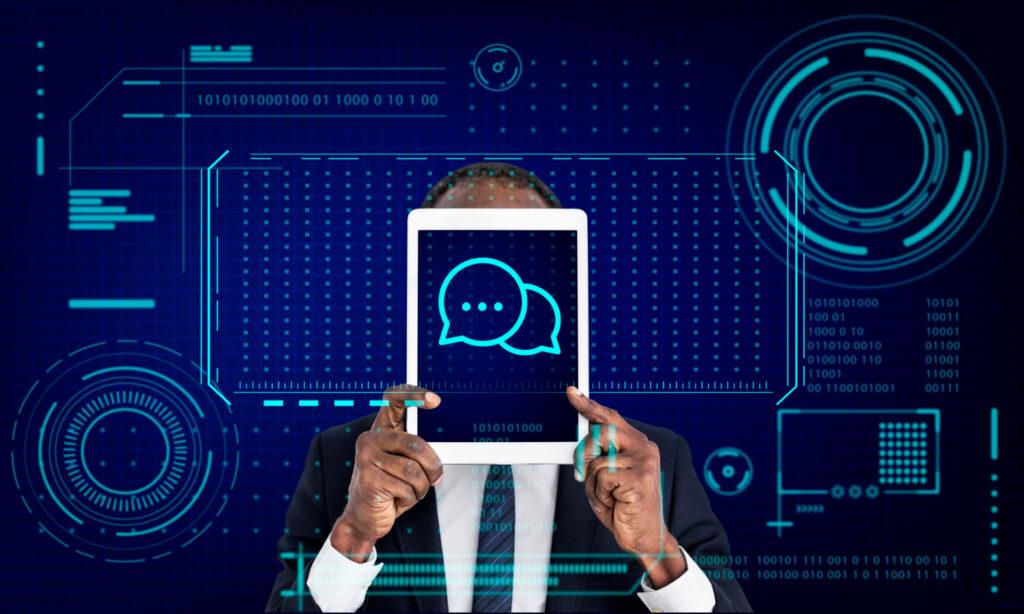Chatbots have revolutionized the way businesses interact with their customers, and their impact on marketing strategies cannot be overstated. In this article, we will explore the world of chatbots and their role in modern marketing. From understanding the basics of chatbot technology to selecting the right platform for your marketing needs, we will delve into how businesses can leverage chatbots to enhance lead generation, customer acquisition, engagement, and support. Additionally, we will discuss measuring chatbot performance and provide valuable tips for successful chatbot marketing implementation. Join us on this journey as we uncover the power of chatbots in transforming marketing practices and driving business growth.
Table of Contents

Introduction to Chatbot for Marketing
Understanding the Basics of Chatbot Technology
When you hear the word “chatbot,” you might conjure up images of a futuristic robot chatting away with customers. While that would be pretty cool, chatbots are actually computer programs designed to simulate human conversation. They use AI and natural language processing to understand what users want and to answer their questions.
Evolution and Growing Importance of Chatbots in Marketing
Since they were first made, chatbots have made a lot of progress. In the beginning, they were simple and didn’t do much. But today, they have evolved into powerful marketing tools. With the rise of messaging apps and the need for personalized customer experiences, chatbots have become an essential component of modern marketing strategies. They can engage with customers, answer FAQs, provide recommendations, and even facilitate transactions.
Understanding the Role of Chatbots in Modern Marketing

Benefits of Using Chatbots in Marketing Campaigns
Using chatbots in your marketing campaigns can bring a multitude of benefits. They can improve customer engagement by providing instant and personalized responses, leading to higher customer satisfaction. Chatbots can handle repetitive tasks, giving your team more time to focus on strategic initiatives. They also provide valuable data insights that can help you understand customer preferences and behavior.
Types of Marketing Tasks Chatbots Can Handle
Chatbots are versatile and can handle various marketing tasks. They can assist with lead generation by collecting user information and qualifying potential leads. They can also nurture leads by sending personalized messages and recommendations. Additionally, chatbots can support customer service efforts by answering FAQs and resolving issues. From lead generation to customer support, chatbots have got your marketing tasks covered.
Choosing the Right Chatbot Platform for Your Marketing Needs
Evaluating Different Chatbot Platform Options
When embarking upon the selection of a chatbot platform, the discerning eye must take into account a trifecta of critical factors: functionality, integration prowess, and user-friendliness. The landscape of optimal choices is enriched by platforms that present an expansive repertoire of capabilities, encompassing the likes of natural language processing, analytics proficiency, and seamless API integrations. Equally pivotal is the harmonization of this selection with the economic parameters and technical competencies of your enterprise. In this dynamic evaluation, the convergence of these considerations culminates in the judicious choice of a platform, poised to empower your chatbot endeavors with dexterity, finesse, and the potential to realize multifaceted objectives.
Considerations for Selecting the Ideal Chatbot Platform
Besides functionality, there are a few other factors to consider when choosing a chatbot platform. Evaluate the scalability of the platform to ensure it can handle your expected traffic. Think about how much the platform can be changed and how flexible it is. And don’t forget about ongoing support and updates. Choosing the right chatbot platform will set you up for success and make your marketing efforts a breeze.

Designing and Developing an Effective Chatbot Marketing Strategy
Identifying Marketing Goals and Objectives
Before diving into chatbot marketing, clearly define your goals and objectives. Do you want more people to know about your company, more leads, or happier customers? Understanding your objectives will help you design a chatbot strategy that aligns with your overall marketing goals.
Defining the Target Audience for Chatbot Marketing
Knowing your target audience is key in designing an effective chatbot marketing strategy. Who are your customers? What challenges do they face? By understanding their needs and preferences, you can tailor your chatbot’s tone, language, and recommendations to resonate with your audience.
Crafting a Compelling Chatbot Personality and Tone
Chatbots don’t have to be boring. Inject some personality and wit into your chatbot’s responses to make the conversation more engaging and enjoyable for users. Whether you want your chatbot to be formal and professional or casual and friendly, finding the right tone will help create a memorable and delightful experience for your customers.
Now armed with these tips, go forth and conquer the world of chatbot marketing. With the right strategy and a touch of charm, your chatbot can be a powerful ally in driving your marketing efforts to new heights.
Leveraging Chatbots for Lead Generation and Customer Acquisition
Chatbots aren’t just for answering customer questions anymore. They can also play a vital role in generating leads and acquiring new customers. By creating lead generation flows with chatbots, you can capture valuable information from potential customers and turn them into qualified leads. Whether it’s through interactive quizzes, surveys, or personalized recommendations, chatbots can engage users and collect data that can be used for targeted marketing campaigns.
Using chatbots to qualify and nurture leads is another powerful strategy. Once you have captured a lead, chatbots can automatically follow up with personalized messages and content to keep them engaged. By asking qualifying questions and understanding their needs, chatbots can help identify the most promising leads and guide them through the sales funnel.
Integrating chatbots with CRM systems is essential for streamlined lead management. By syncing chatbot data with your customer relationship management software, you can ensure that all lead information is captured and easily accessible. This integration allows your sales team to efficiently follow up with qualified leads and track their progress, ultimately improving your overall conversion rates.
Enhancing Customer Engagement and Support with Chatbots
Chatbots have emerged as a remarkable solution for elevating customer engagement and support in the digital age. Leveraging personalized interactions, these intelligent virtual assistants have the capability to create truly outstanding customer experiences. This is achieved by delving into the wealth of user data and preferences, allowing chatbots to craft individualized product suggestions, exclusive promotions, and relevant content that deeply connect with customers. By seamlessly amalgamating technology and personalization, chatbots redefine the way businesses connect with their clientele, fostering lasting relationships built on mutual understanding and value.

The utilization of chatbots brings forth an array of significant advantages, with real-time support and assistance standing out prominently. Gone are the days of waiting for a customer service representative’s availability; instead, users now enjoy the privilege of instant responses to their inquiries through the adeptness of chatbots.
These AI-powered assistants excel at addressing frequently asked questions, furnishing step-by-step troubleshooting instructions, and seamlessly transitioning to a human agent for intricate concerns when the situation demands. By providing this swift and effective support mechanism, chatbots not only elevate customer satisfaction levels but also cultivate unwavering loyalty from a user base that values timely and dependable assistance.
Proactive customer engagement stands as yet another compelling advantage offered by chatbots. Through the astute utilization of behavioral cues and user data, chatbots exhibit the capacity to initiate interactions with customers, presenting them with pertinent offers, timely reminders, and essential updates. To illustrate, consider a scenario where a chatbot takes the initiative to send a customized message to a customer who has left their shopping cart unattended, skillfully nudging them towards finalizing their purchase decision. This proactive demeanor plays a pivotal role in not only augmenting sales figures but also ensuring that your brand maintains a prominent position in the minds of consumers, fostering lasting brand affinity and recognition.
Measuring and Analyzing Chatbot Performance for Marketing Success
To ensure the success of your chatbot marketing efforts, it’s important to measure and analyze chatbot performance. Identifying key performance indicators (KPIs) specific to chatbot marketing can help you monitor and optimize your campaigns. Metrics such as engagement rate, conversion rate, and customer satisfaction can provide valuable insights into how well your chatbot is performing.
Tracking and analyzing chatbot conversations and user interactions is crucial. By reviewing chat logs and user feedback, you can identify areas for improvement and make necessary adjustments. Analyzing user preferences and behavior can also help you refine your chatbot’s responses and personalize the user experience. Additionally, tracking conversion rates and customer outcomes can help you evaluate the chatbot’s impact on your marketing goals.
Optimizing chatbot performance based on analytics and insights is an ongoing process. Regularly reviewing and refining your chatbot’s capabilities ensures that it continues to deliver value to your marketing efforts. By leveraging the data and feedback gathered from users, you can make informed decisions about updates, enhancements, and new features to further improve customer engagement and satisfaction.
Best Practices and Tips for Successful Chatbot Marketing Implementation (Chatbot For Marketing)
The successful implementation of chatbot marketing hinges on the diligent application of several key best practices and invaluable tips. Foremost among these is the unwavering commitment to delivering a flawless user experience. This entails fashioning a chatbot that exudes intuitive usability, featuring lucid instructions and effortless navigation pathways. Striking a harmonious balance is crucial; resist inundating users with an overwhelming array of choices or an abundance of text.
Instead, cultivate an atmosphere of light-heartedness and interaction that captures user attention and sustains their engagement. Imbuing your chatbot’s responses with a distinct personality further solidifies this connection, creating a memorable and relatable interaction that resonates with users on a deeper level.
Proper chatbot training and testing are crucial before launching your chatbot into the wild. Train your chatbot to understand various user inputs and provide appropriate responses. Test it thoroughly to identify any gaps or areas for improvement. Solicit feedback from users during the testing phase to uncover bugs or usability issues that your team might have missed.
After your chatbot goes live, the pivotal factor for sustained success lies in the realm of continuous improvement. A steadfast commitment to this principle involves the consistent analysis of user feedback and interaction data, a process that unveils valuable patterns and illuminates potential pain points. Armed with these insights, the quest is to elevate your chatbot’s capabilities by means of frequent updates and refinements.
Through a perpetual cycle of iteration and enhancement, your chatbot can persistently evolve, adapting harmoniously to the ever-changing landscape of user requirements. This dedication to refinement not only preserves its effectiveness but also assures that it remains finely attuned to the dynamic needs of your target audience, thereby cementing its position as a stalwart asset in your engagement strategy.
Remember, chatbots are not meant to replace human interaction entirely. They should complement your existing customer support and marketing efforts. Finding the right balance between automated assistance and human touch is crucial for building meaningful relationships with your customers. So, don’t be afraid to inject your chatbot with some personality and humor to create a delightful and memorable experience. In conclusion, chatbots offer tremendous opportunities for businesses to elevate their marketing efforts and connect with customers in more meaningful and efficient ways.
By understanding the role of chatbots, selecting the right platform, designing effective strategies, and continuously measuring and improving performance, businesses can unlock the full potential of chatbot marketing. Embracing this technology can lead to enhanced customer engagement, improved lead generation, and streamlined support processes. As chatbots continue to evolve, it is crucial for businesses to stay informed and adapt their marketing strategies accordingly. By harnessing the power of chatbots, businesses can stay ahead of the curve and drive success in the ever-changing landscape of digital marketing.
FAQ
1. What is a chatbot and how does it work in marketing?
Chatbots represent computer programs harnessing the power of artificial intelligence to emulate human conversational patterns. Within the realm of marketing, these versatile entities find integration across a spectrum of platforms, encompassing websites, social media channels, and messaging applications. Their purpose is to actively engage with customers, encompassing tasks ranging from query resolution and dispensing information to facilitating purchasing decisions.
The underpinning mechanism relies on their adept utilization of natural language processing, enabling them to comprehend user inputs in a contextual manner and furnish pertinent and contextual replies. The net result is a remarkable augmentation of customer interactions—marked by seamlessness and personalization—ushering in a new era of enhanced engagement and tailored experiences.
2. How can chatbots benefit my marketing efforts?
Chatbots offer numerous benefits for marketing. They are available 24 hours a day, seven days a week, so companies can talk to people at any time. Chatbots can handle repetitive tasks, such as lead generation, customer support, and product recommendations, freeing up human resources for more complex activities. They also enable businesses to gather valuable customer data and insights, which can be used to improve marketing strategies and personalize customer experiences.
3. How do I choose the right chatbot platform for my marketing needs?
Selecting the right chatbot platform requires careful consideration. First, determine your marketing goals and objectives to identify the features and capabilities you require. Consider factors such as ease of use, scalability, integration options with your existing systems, and compatibility with various communication channels. Additionally, evaluate the platform’s natural language processing capabilities, analytics and reporting functionalities, and customer support services to ensure it aligns with your specific marketing needs.
4. How can I measure the performance of my chatbot in marketing?
Quantifying the efficacy of chatbot performance necessitates the identification of pivotal key performance indicators (KPIs) encompassing customer engagement, conversion rates, and overall customer satisfaction. The arsenal for measurement is enriched by the tools and analytical instruments inherent in chatbot platforms. These resources empower the monitoring of essential metrics, spanning user interactions, duration of sessions, and the culmination of successful conversions. Consistent analysis of data bestows a profound understanding of user behaviors, inclinations, and points of friction, thereby providing the foundation to optimize chatbot operations. This iterative process hinges on perpetual vigilance, encompassing both monitoring and refinement, all with the overarching objective of enhancing the chatbot’s prowess in effectively realizing marketing objectives.









